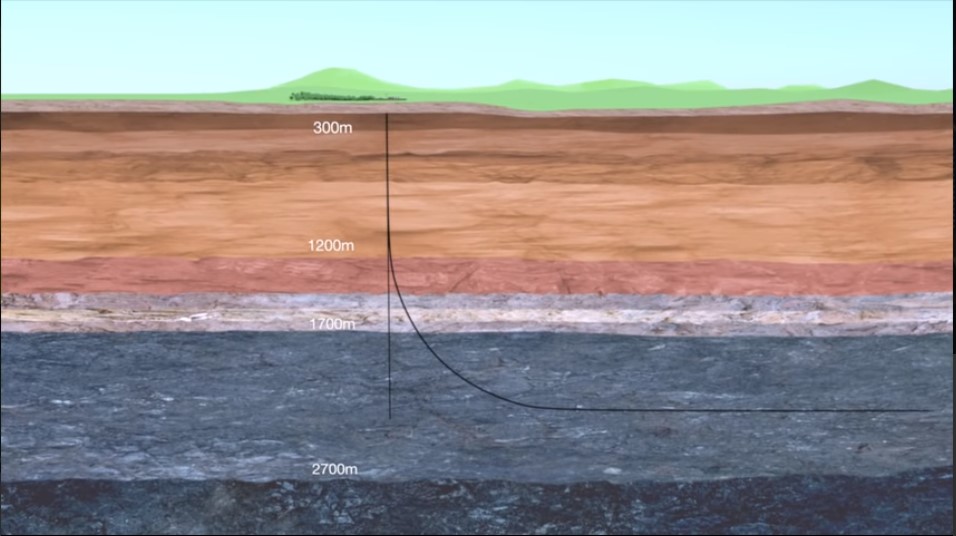
Graphic of drilling through an idealised shale rock layer. Source: Cuadrilla Resource
In the past few years, the locations of geological faults and even whole rock strata have moved as we learn more about the geology below Cuadrilla’s Lancashire fracking site.
In this guest post, Fylde geologist Trina Froud reports on why this matters and warns that regulators could have been “working blind” because of a reluctance to share data.
There are a number of knowns and unknowns surrounding the exploration of a shale gas pad.
The knowns include change of use of land, noise, light, trucks, concerned residents. The unknowns include questions about long-term well integrity and the geology – what does the subsurface look like and how will it behave?
To explore for shale gas, a company needs to have a picture of the subsurface to find out where the shale is, and how best to access it. In a new area the company would normally conduct a 3D seismic survey to find out.
A number of professional geologists consider that survey data should be openly available but, under the licence system in the UK, it has been commercially-confidential in Cuadrilla’s Fylde licence area for more than five years. So:
- What do we know of the survey results?
- What confidence can we place in Cuadrilla’s interpretation?
- Why does it matter?
- What can be done about it?
Shale, surveys and a slipping fault
Cuadrilla is searching for shale gas in the Bowland Shale. The rock formation has had quite a complex geological history in the area. This explains why the rocks are 2km underground in the Fylde, but 17 miles away in the Bowland Fells they are found at the surface.
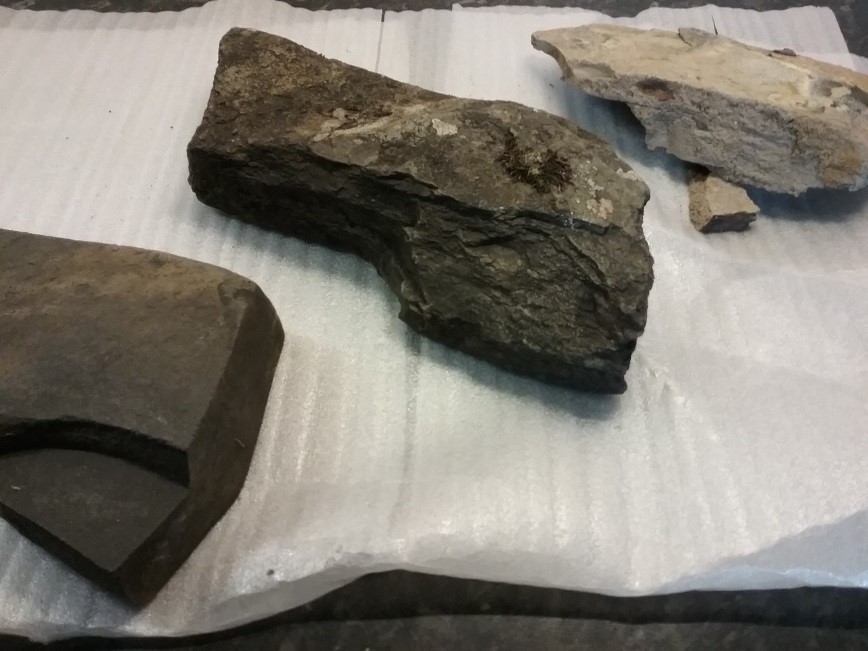
Shale rocks (from left to right): Lower Bowland Shale from dense tough bed of black cherty/siliceous limestone; Lower Bowland Shale showing layers of mud; Upper Bowland Shale, very flaky, weathering to a lighter colour on the surface. Photo: T Froud
Before Cuadrilla drilled and fracked at Preese Hall in April/May 2011, Professor Peter Styles, then at Keele University, advised the company to do a new seismic survey and install local seismic monitoring. The company didn’t.
Cuadrilla relied on an older 2D seismic survey that was offset to the planned well. This meant that it had an incomplete picture of the subsurface. During operations, fluid migrated into a fault which then slipped, caused more than 50 tremors (including one months later in Aug 2011) and deformed the well over a significant interval.
The consequences, apart from loss of the well, were a moratorium, a series of reports, reviews and studies, a growing public awareness of fracking ….. and a pause of 7 years.
The lesson learned could be summed up:
“A survey is expensive but drilling in the wrong place is a jolly sight more expensive”.
What surveys show …
A seismic survey indicates the type, thickness and depths of rock layers below the surface. It also shows the structure, such as the folds and faults resulting from geological upheavals.
Subsequently, during drilling, core samples can be taken and instrumentation used in the well to gather information about the rocks, and all this data is used to correlate with the survey results.
The ideal geology would be like a neat layer cake or the banner produced by Cuadrilla:
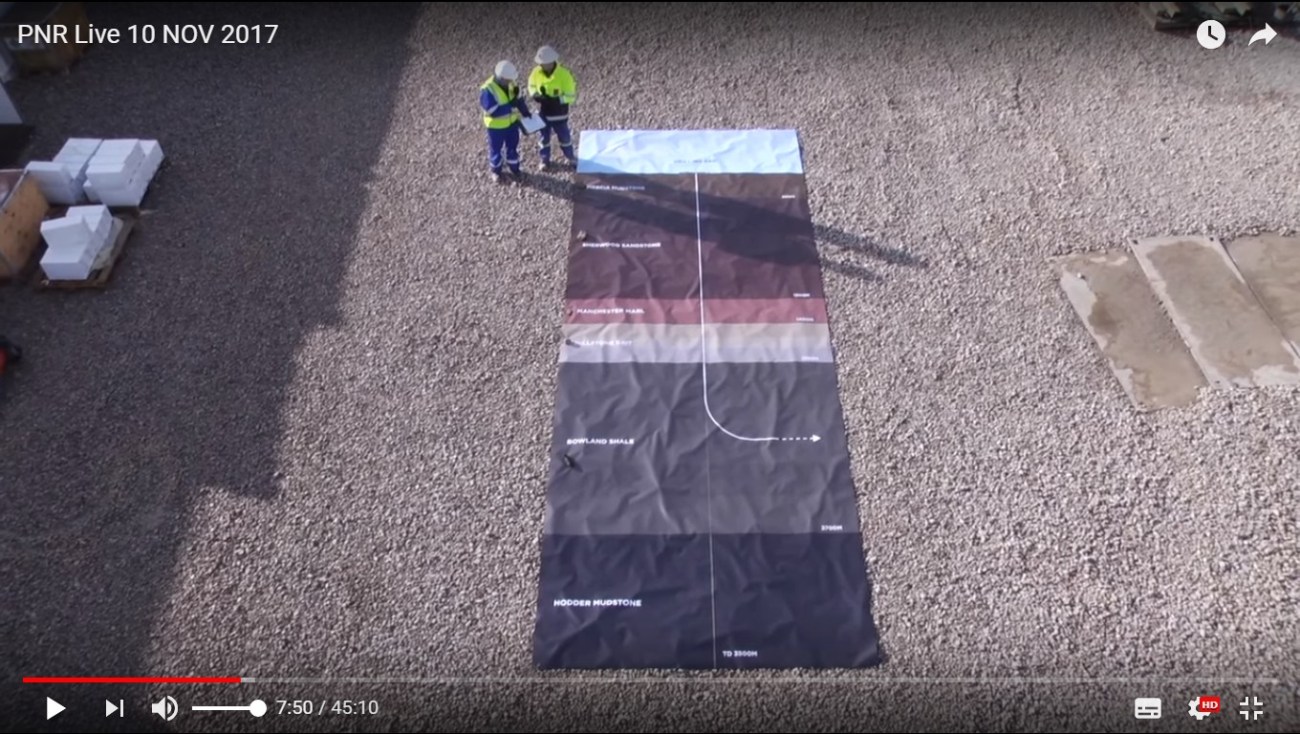
But when Cuadrilla carried out a seismic survey in 2012, the picture was rather different. The Environmental Statement for the proposed Roseacre Wood site depicted the subsurface like this:
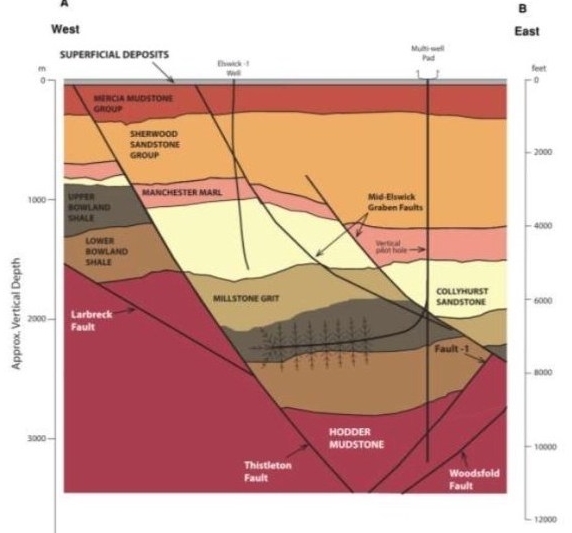
Graphic included with Cuadrilla’s environmental statement for its Roseacre Wood site. Source: Cuadrilla Resources
Cuadrilla’s 3D seismic survey was due to be released in January 2018, but was not authorised for release until September 2018. This was too late to be reviewed by the wider scientific community, because all the permissions had been given to frack the first well at Preston New Road by that time.
So the only access that academics and independent geoscientists have had, is to tiny seismic slices and equally limited coloured interpretations of the geology, shown in the planning applications, and more recently, in the Hydraulic Fracture Plans (HFP) submitted by site operators to the regulators.
… and how the picture changed
An HFP ought to contain data that can be obtained only from drilling, and that point is made in the HFP for Kirby Misperton. However, Cuadrilla issued its HFPs before or just as it started drilling.
Cuadrilla’s HFP for its first well – PNR1/1z – went through several iterations before it was finally accepted and now includes data gained during drilling.
You can compare the graphic (immediately below) in the original HFP for well 1, pre-drilling and based only on the 3D survey, with the second graphic produced after drilling in the revised and longer HFP:
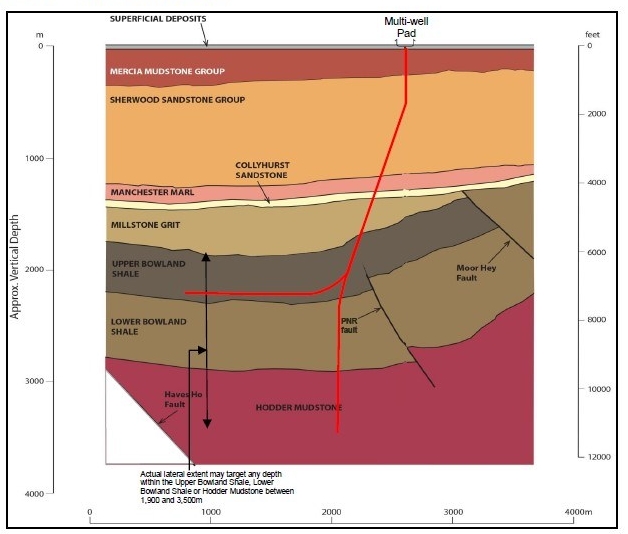
Graphic in the Preston New Road HFP pre-drilling and based only the 3D seismic survey. Source: Cuadrilla Resources

Graphic in the Preston New Road HFP produced after drilling. Source: Cuadrilla Resources
There are several differences between the two graphics:
- the vertical pilot hole does not go below the Lower Bowland Shale as had been proposed
- the lateral was drilled into the Lower Bowland Shale rather than the Upper Bowland Shale
And the geological interpretation has changed:
- the band of Millstone Grit Icoloured light brown) that Cuadrilla predicted from their 3D seismic survey, was simply not present at the location of the pilot well
- Fault-1 extends much higher and is now portrayed with a splay of smaller faults towards the top in the Upper Bowland Shale
- Crucially the well is drilled through the fault
Now compare this to the graphic in the HFP for well 2, issued after drilling that well.

Graphic produced for the Preston New Road second well (PNR2). Source: Cuadrilla Resources
Further changes have been made. The geological interpretation close to the Moor Hey fault has changed, even though neither well was drilled nearby and no further survey has been carried out in that area.
The whole picture is very different from the graphic in the planning application made to Lancashire County Council in 2014:

Graphic in Cuadrilla’s planning application to Lancashire County Council in 2014. Source: Cuadrilla Resources
Should we trust the graphics?
Both the way the survey is carried out (the data acquisition), and the way the data is processed, can affect the results of the subsequent interpretation.
In Cuadrilla’s licence area, PEDL165, the seismic survey and the data processing were carried out by CGG Veritas, and the subsequent interpretation was by Cuadrilla.
Emeritus Professor David Smythe, formerly of Glasgow University, has had concerns for several years about the interpretation of the seismic survey, particularly the faults. He raised these issues with Lancashire County Council’s planning officers in 2014 and 2015. He discusses the issue further in this recent article.
The changes to the graphics over the last four years, show that the Cuadrilla has not found it easy to interpret the results of this 3D seismic survey.
Millstone Grit and Shale are very different rocks, and have different characteristics. Therefore, it is rather surprising to me that they expected to find 1,000ft of Millstone Grit at the location of the pilot hole, which actually turned out to be shale.
The latest HFP states:
“At the Preston New Road Site, the Millstone Grit overlies the Upper Bowland Shale. Observations in section t “Well Observation” identify the Millstone Grit to be absent at the PNR1 well pilot hole location, however 3D seismic data shows the Millstone Grit present vertically above the lateral well (PNR 1z).”
Given that this same survey data was misinterpreted at the pilot hole location, what level of confidence can the regulators have that it has now been correctly interpreted elsewhere?
And does it matter?
A full understanding of the structure of the subsurface is important. It is a necessary precursor to, and underpins the ‘safety’ of, any unconventional hydrocarbon development, because the behaviour of that structure is even less well understood.
- Faults can slip causing tremors and/or damaging well
- Faults can transmit fluids in the horizontal direction
- Faults can transmit fluids upwards
We know that a fault slipped at Preese Hall and caused deformation to the well. Professor Richard Davies, of Newcastle University and the Research in Fracking in Europe project, has raised concerns that these PNR wells are drilled through a fault, and that “if it slipped there will be a well integrity issue”.
We know that the EA analysis of the flowback fluid from the Preese Hall well showed that it contained a wide range of salts, heavy metals, low level radiation, all of which came from the shale. Some of these substances were at many times the concentrations found in the drinking quality water that was used to frack. We also know that Cuadrilla’s former Technical Director Andrew Quarles said in 2015:
“We have been estimating we will get back 40% of flowback. There are lots of theories. No-one knows exactly what is going on or where the water goes or where the final resting place is.The water could go into the fractures created by fracking or it could be absorbed into the shale formation”
We know from Cuadrilla’s geologist, Huw Clarke that the Morecambe Bay gas fields were formed when Bowland Shale gas migrated up through faults in the Manchester Marl, collecting in the Sherwood Sandstone Group.
The mechanism of induced seismicity is not fully understood and is the subject of current research. The effect of faults on the compartmentalisation of groundwater is also a current research paper.
A group of geoscientists from Durham and Newcastle Universities have said:
“The shale formations that are currently targeted by fracking in England are highly (naturally) faulted. … The new challenge, however, is working out how stressed these faults are.”
Commenting on the recent tremors, Professor Stuart Haszeldine, at the University of Edinburgh, said:
“The practical significance is … in the potential to damage the borehole, and the potential to create gas pathways from the shale towards larger faults, towards shallower aquifers, and to the surface”.
There are a lot of unknowns and yet academic recommendations to minimise the risks – for example by maintaining a respect distance from faults proposed by Professor Styles – have not been heeded.
The risks of delayed data release
I have no doubt that interpreting the results of a 3D seismic survey is a specialist skill, and clearly Cuadrilla experienced difficulties.
I observe that the company had five years to study the data. If the results were not sufficient to assess properly the subsurface at Preston New Road, the company had the option to re-run a limited survey for these wells or reprocess the data in that area. This is particularly important when drilling proved that the Millstone Grit was not present.
Cuadrilla’s 3D seismic survey was due to be released under the terms of their licences (for PEDL 165, EXL 269), in January 2018, but Cuadrilla asked the industry regulator, the Oil & Gas Authority to withhold it.
If the data had been released in January 2018, independent scientists would have had time to assess these interpretations and raise any concerns about, for example, the position of faults relative to the wells or the location of British Geological Survey (BGS) groundwater monitoring stations relative to the faults.
To the best of my knowledge, neither Liverpool University, which has been working on triggers of induced seismicity, nor the Durham/Newcastle and ReFINE geoscientists working with Professor Davies, have seen the data. When last I asked, the BGS had not seen the data either, and of the three regulators, only the OGA has had access.
The issues that concern Fylde residents near the well sites are not about seismicity that can be felt on the surface. They are all about what is happening subsurface and which could have long-term consequences.
Exploration for hydrocarbons should be conducted with the stewardship of the environment in mind. The subsurface and its behaviour are unknowns, and fracking is such a controversial topic, that the survey data needs to be viewed by the other regulators and examined by independent experienced scientists before any further exploration is carried out.
In particular, it is of deep concern to me as a resident, that regulators who are making crucial decisions about fracking, are doing this ‘blind’.
Categories: guest post


Ahh, you have spotted there are less than the sum of the parts, Judith!
It is not new on this site, and “they” are not that good at it. It was exposed before, but it seems a game that is impossible to resist. A defence mechanism observed in many species.
Numbers seem important, but not logic, science or common sense.
Interesting article in the Times today-“Hydrogen gas plan for millions of homes.” (And then, hydrogen for vehicles?)
The chemistry for this was proposed by both Oxford and Cambridge a while ago, where there were statements supporting decarbonising existing fossil fuels.
So, hydrogen from gas.
Seems this is now taking some shape, supported by Equinor-the Norwegian company that supplies around 25% of Britain’s gas needs.
Around £50 added annually to the energy bill for every UK home.
That is the crunch. How about using UK sourced gas and inject the taxation from that to achieve the same objective without the householder picking up the tab? Looking at the geography for the proposed siting, Sir Jim might have some available locally!
Equally, whilst storage of CO2 in saline aquifers may be one mechanism, I suspect there are more profitable ways to deal with CO2, to utilise it rather than just to dispose of it.
I suspect this technology, plus (maybe) fusion, could be the core of UK energy supply in the future supplemented by some “alternatives.”
As someone clearly well informed in taxation and costs to householders Martin, perhaps you could tell us what every household pays in subsidy and tax breaks to the hydrocarbon industry, past present and future? Maybe take an educated guess at the collective cost of worstening and nigh on uncontrollable global warming that will manifest itself as social cost? Also who that cost will predominatly fall on?
The interesting account of the geology at Preston New Road has aroused an unusual number of comments.
It’s good to see conributions from people with practical experience in the industry.
I noted, with relief, that expert Judith Green wrote, “there really aren’t significant dangers in fracking for shale; it’s one of the safest way to take hydrocarbons out of the ground” and “wells in shale are easier to control than in any other rock”.
I’m puzzled though.
There were many tremors recorded by the BGS from the 18th Oct when fracking had just started at Preston New Road. Some were over the permitted limit of 0.5. However these have stopped for the last 2 weeks and people nearby observe very little activity on the site.
As indicated by the problems at Preese Hall in 2011, I’m wondering if the much faulted Lancashire shale is again proving tricky to drill. Has the wellbore, despite best hopes, been damaged by tremors and slipped shale.
Can anyone familiar with the industry explain the situation?
Depends on the taxation being EARNED from oil and gas, Mike. Quite a lot in UK, could be a lot more. How about the dividends payed out to individuals, including pensioners, and to Councils? Do you want to include the income and jobs from industry that is still dependent upon oil and gas?
Of course it could be improved if certain individuals didn’t give that industry opportunity to utilise tax allowances against interruption and delay to their operations.
Meanwhile, 1100 new jobs just announced at Vestas. Pretty clear indication that it is not a case of either/or.
You appear to have evaded my questions completely Martin…. again. Confusing the issue by answering a question with a similar, but unrelated issue. Are you a Minister in disguise?
Why should the subsidies to a hydrocarbon industry (well established for c 100 years) be dependent on taxation income from an industry that clearly must be winding down. Besides, you are referring to the well established conventional industry, not the as yet completely unestablished frackers.
Good to hear about new renewables jobs at Vesta based purely on private investment, despite the fact that this govt have been trying to hammer renewables – particularly on shore wind at every turn.
Mike – if hydrocarbons are subsidised, which they are not, the UK should be handing out more because it seems pretty clear that the wealth of most countries seems to be quite closely correlated between the amount of hydrocarbons the produce divided by their population
For someone who has appeared only recently as a commentator on this site, you have an extaordinary depth and breadth of knowledge of the hydrocarbon industry Judith. I’m afraid I’m no expert in state subsidies, but it’s good to hear the expert opinion that Billions (if not Trillions) handed out in O&G subsidies worldwide are pure fantasy. Given that close on 100% of expert opinion, climate models and governments globally agree that AGW is man made, happening now and nigh on irreversible, why therefore did our govt pump millions into PR for a fracking industry that will by necessity be obsolete by the time it can get fully established in England? Isn’t that what we call a subsidy? What about special tax agreements for the O&G industry. Isn’t that a subsidy, or am I missing something. Perhaps others more knowledgeable can confirm the complete lack of subsidy to the fossil fuel industry? And perhaps confirm that Judith is right and now is just the right time to start.
The actual reason for the pause Muriel, will become clear as time goes by. Cuadrilla have stated they will not give a constant commentary.
However, having gained authorisation at PNR there are not many, apart from some small groups, who would expect a test to consist of continuous operations. Most tests in most industries usually involve doing something, pausing and reviewing and then either doing the same again or doing it in a slightly modified way, and so on. But, of course, it also gives vast opportunity for speculation.
Reblogged this on keepeastlancashirefrackfreekelff.
Let me assure the writer of this Guest Post that local residents are very concerned about the above ground effects of the Hydrofrac Earthquakes generated by Cuadrilla at the Preston New Road test fracking site. As well as the many other dangers posed by the industry of course.
My earthquake concerns have unfortunately come to pass as my family home was damaged by the 2019 August Bank Holiday Weekend Hydrofrac Earthquakes. I am presently following through on my legal options which task has already taken me the best part of six months!